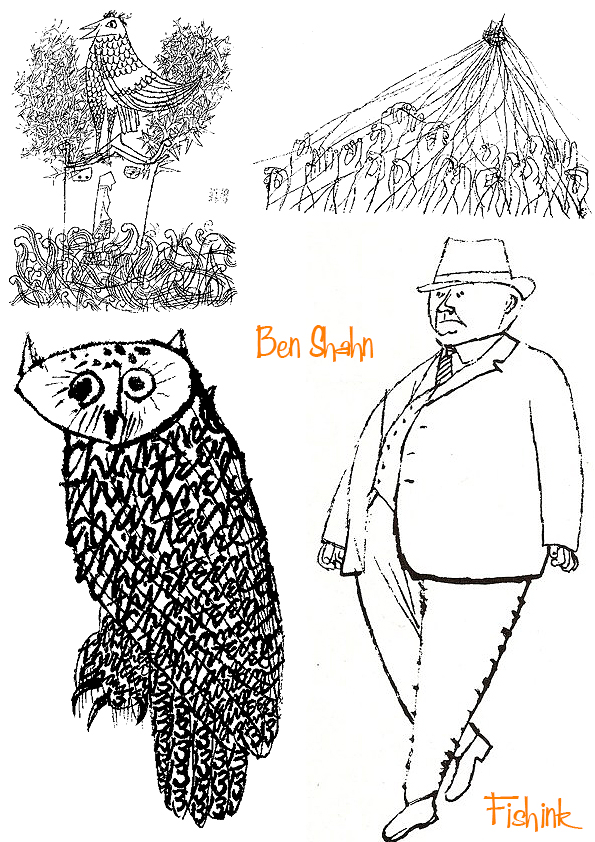Ben Shahn
Hi Everyone, before I start with this week’s post, I would just like to say that I have a Ceramics Sale this Saturday on Instagram at Fishinkblog . It starts at 10 AM UK time and I would really appreciate it if you could spread the word for me. I make original, creative ceramics and can ship worldwide, so do pop over and see for yourself in my stories and on my feed. Or message me craig @ fishink .co.uk if there is anything you would like to buy if you are not on instagram and I will return your message asap. Thank you.

and here’s today’s post… enjoy !

Ben Shahn (1898–1969) is one of the most admired and collected artists of his generation, he was a painter, photographer, printmaker and political activist, who is best known for his poignant narrative paintings of American life.

Shahn was born in Kovno, Lithuanian and his father, a socialist and fervent anti-czarist, was exiled in 1902 for participating in revolutionary activities. His father eventually immigrated to the United States, and in 1906, a young Ben Shahn and his siblings joined him in New York City. At fourteen, Shahn apprenticed with a Manhattan lithographer (1913-16). His lucrative career as a journeyman lithographer made it possible for him to finance his academic and artistic education, and he attended the Art Students League (1916-17), New York University (1919), City College of New York (1920-21), and the National Academy of Design (1921).



In 1925 and 1928, he took extended trips to Europe, studying old master paintings and the work of European modernists. Shahn did not subscribe to the avant-garde philosophy that art existed in a realm above the concerns of everyday life. On the contrary, he believed that artists had a moral obligation to express their social and political views through art. He stated: “It is not just the artist’s experience, but his values, his judgments… that live in the work of art and make it significant to the public.”



In 1929, Shahn shared a Manhattan studio with photographer Walker Evans. With Evans’s encouragement, Shahn began taking photographs of New York City, and during the Great Depression, Shahn joined the staff of the Special Skills Division of the Resettlement Administration/ Farm Security Administration (RA/FSA) (1935). In addition to his work with the RA/FSA, Shahn executed murals for the Federal Art Project and the Public Art Section of the Treasury Department and continued to work on his own easel paintings.

In 1932, Shahn had his first critical and commercial success when his series The Passion of Sacco and Vanzetti was exhibited at Edith Halpert’s Downtown Gallery in New York City. a painting which condemned the controversial conviction of two Italian-American immigrants who were sentenced to death in 1927.


In 1942, Shahn began working for the Office of War Information (OWI), creating posters for the government’s anti-fascist propaganda campaign. However, OWI officials rejected most of his designs because they were considered too violent; he resigned in 1943. From 1944 to 1947, Shahn worked for the graphics division of the Congress of Industrial Organization’s Political Action Committee (CIO-PAC), and in 1948 he was a member of the graphic arts division on Henry Wallace’s Presidential campaign.



During the Cold War, Shahn’s work became increasingly symbolic and allegorical, yet he continued to assert that art should be a means of political expression.

Even though right-wing politicians attacked his work as communistic, by the late 1940s Shahn was one of the few American artists who could earn a living solely from painting.



Despite his celebrity, he continued working as a graphic artist and serving the social and political causes he believed in. In 1947, Shahn had his first major retrospective at the Museum of Modern Art, and in 1954, MoMA organized a second exhibition for the American Pavillion at the 27th Venice Biennial.


Shahn continued to paint, illustrate, teach and remain politically active until his death in 1969, at the age of 71.




Today, Shahn’s works are held in the collections of the Art Institute of Chicago, the Whitney Museum of American Art in New York, the Tate Gallery in London, and the National Gallery of Art in Washington, D.C., among others.
Many thanks to the Michael Rosenfeld site for the information about Ben. There’s a great essay and another lenghthier piece with much more info here and here.



Love his work.
Actually I believe I met him once or twice.
He was a friend of my father (Bill Sokol)
Ben gave me a print of an owl, which
sadly disappeared.
Thanks for all your work.
When I and if I ever get back to New York
I will send you some of my father’s commercial work.
Thanks Kathy for your comments. I hope this finds you well. Craig